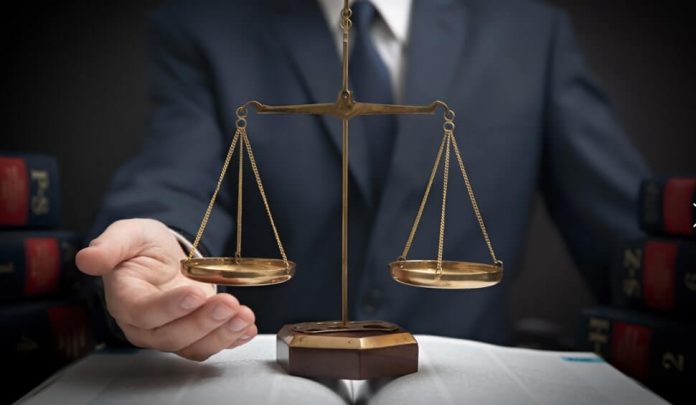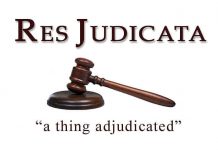This article has been written by Raksha Yadav, studying BBA.LL.B and pursuing a Diploma in General Corporate Practices: Transactions, Governance, and Disputes from LawSikho. The article explains the difference between res judicata and res sub judice. It also provides deep knowledge of both elements.
It has been published by Rachit Garg.
Table of Contents
Introduction
The judiciary always refers to certain principles, doctrines, and precedents to pronounce judgment in any suit. These doctrines play an immense role to make the judiciary work efficiently and pace the speed of delivering judgment. In our country, the litigation process is very time-consuming and expensive due to the large number of cases filed every day. Hence, there are two doctrines, i.e., res judicata and res sub judice, under the Code of Civil Procedure, 1908 (CPC), which aim to provide efficiency and speedy process during proceedings.
‘Res judicata’ is a Latin maxim that says the ‘matter has been decided. This doctrine states that when a suit has been heard by the court on similar facts and issues, a final judgment is passed. If the issue is no longer appealable, then this doctrine prohibits continuing the proceedings on the same grounds and same parties.
On the other hand, ‘res sub judice’ is also a Latin maxim that means ‘under the judgment’. When parties file two or more suits on the same matter, then the competent court has the authority to hold the parallel proceedings of the suit. The doctrine ordains a stay of suit to avoid duplication and contrary orders.
Difference between res judicata and res sub judice
Meaning and Definition
Res judicata
Res means a subject matter, and judicata means adjudged. The doctrine of res judicata is adopted from ‘res judicata pro veritate accipitur’ which states that once the decision has been made, it must be accepted as true and final. It developed from English common law. The common law system was developed from the fundamental idea of judicial uniformity. Res judicata was initially adopted from common law into the Code of Civil Procedure, and later it was adopted into the Indian legal system. Section 11 of the CPC deals with the provision of res judicata. According to this Section, a court can not entertain any suit which has been settled on similar facts and issues as those that were directly or subsequently dealt with in a former suit. The proceedings took place in a competent court under a similar title.
The doctrine, which is also known as claim preclusion, prohibits a party from starting new legal actions against the same parties over the same facts and grounds.Several times, a party initiates the proceedings again just to harass the other party. Hence, to prevent the repentance of filing a similar suit, this doctrine is applicable.
In Satyadhyan Ghosal and Others v. Sm. Deorajin Debi and Another (1960), the Supreme Court explained that the doctrine of res judicata emphasizes the final settlement of the matter. No party will be permitted to raise the same issue in a subsequent suit or proceeding between the same parties when a matter, whether on a question of fact or law, has been resolved between two parties in a single proceeding and the decision is final, either because no appeal was filed with a higher court or because the appeal was rejected, or because no appeal is viable.
In Daryao and Others v. The State Of U. P. and Others(1961), the Supreme Court observed that the principle of res judicata, which states that litigation must conclude, is a fundamental principle shared by all courts and does not merely apply to records.
In Lal Chand (Dead) By L.Rs. & Ors v. Radha Kishan(1976), the Supreme Court stated that once the final decision is made earlier, judges consider it as the res judicata in the present suit that is filed between the same parties.
The doctrine of res judicata is based on certain maxims, which are the following:
- Nemo debet lis vexari pro eadem causa:
This maxim states that ‘no person is tried twice in a similar kind of suit’. It is applicable in both types of suits, civil and criminal, to put an end to the litigation process. Article 20(2) of the Indian Constitution also says that no person shall be prosecuted and punished twice.
- Interest republicae ut sit finis litium:
The meaning of the maxim is that there should be an end to litigation since it is in the interests of the nation.
- Re judicata pro veritate occipitur:
It means a judicial decision must be accepted as it is.
Res sub judice
The term ‘res’ means matter, and ‘sub judice’ means under consideration. Hence, the doctrine means a matter which is still under consideration. Section 10 of the CPC says that no court can initiate such proceedings between the same parties and the same issues which were directly or subsequently in question in the previous suit if the previous suit is still pending in the competent court. The doctrine of res sub judice aims to stay the proceedings when two or more cases are filed in the same court between the same parties. The objective of the doctrine is to avoid wasting the time in court and avoid contradictory decisions in the same suit. It also protects the parties from unnecessary court proceedings and harassment by other parties. The doctrine is applicable to a trial of the suit, appeals, and revision. It does not prevent a court from issuing temporary orders for the granting of an injunction or a stay.
In Escorts Const. Equipment Ltd v. Action Const. Equipments Ltd (1998), the Delhi High Court observed that to invoke Section 10 of the Code, there must be a matter at issue and the parties are the same in a former and subsequent suit; a former lawsuit that was filed in a court with the jurisdiction to grant the desired relief, whether it was in the same court or another.
In Indian Bank v. Maharashtra State Co-Operative Marketing Federation (1998), the Supreme Court stated that the purpose of the doctrine of res sub judice is to avoid contradictory rulings on the subject at hand by preventing courts with jurisdiction from trying two parallel matters at once.
In the case of Arumugha Udayar Rep. by Power v. Lakshmi (2005), the Madras High Court stated that to invoke Section 10 of the Code, there must be four essential conditions:
- The matter at issue in the second lawsuit is also, significantly and directly at issue in the first lawsuit;
- The parties involved in the second lawsuit are the same as the parties under whom they claimed to act on their behalf or any of them;
- The second lawsuit’s relief is admissible in the court where the initial lawsuit was filed;
- The previous suit must be pending in the competent court, or any court situated in India, or the Supreme Court, or any court, or in any court established or formed by the Central Government outside of India.
Purpose
Res judicata
The doctrine of res judicata applies to all civil and criminal cases and is based on the principles of justice, equity, and good conscience. The main aim of the doctrine is to restrict the process of re-litigation. The other purpose of the doctrine is as follows:
- It prevents the time and resources of the court from being misused.
- It provides a safeguard for the defendant from damage.
- It prevents the conflict between the parties in a matter that has been officially resolved by bringing a verdict to an end and barring any future claims.
- It prevents the confusion that might be caused by multiple judgments in a single suit.
Res sub judice
The doctrine of res sub judice also aims to save the judiciary time from unnecessary suits. Apart from this, there are a few more objectives of the doctrine which are as follows:
- It allows the plaintiff to file one suit for all the issues and facts against the same defendant.
- Avoid contradictory decisions on a similar matter in issue.
- Stop the courts with concurrent jurisdiction from concurrently hearing and making decisions on two parallel lawsuits involving the same claim, same issue, and similar remedy.
- Protect the defendant from paying compensation or damages twice.
- Prevent unnecessary confusion.
Essentials
Res judicata
The essentials of res judicata are as follows:
- There should be one former and one subsequent suit filed.
- The matter is directly and substantially related to the subsequent suit.
- The parties who filed suit must be similar to the parties who filed the former suit also.
- The titles of both suits are also the same.
- The suit must be filed in the competent jurisdiction.
- The court must have previously heard and decided the issue that is directly and substantially in question in the subsequent suit.
Res sub judice
The essentials of res sub judice are as follows:
- There must be two civil suits between the same parties.
- The former suit is pending before the competent court for final decision and the subsequent suit is brought.
- The subsequent suit is also filed under a similar title to the former suit.
- Any suit that is pending in a foreign court does not invoke Section 10 of the Code.
- If the subsequent application is filed before the Tahsildar and the suit is pending before the court, then it will fall under the scope of the doctrine.
- The date of the plaint presentation is considered for the institution of the suit, and the appeal is also included in the suit.
- The court must have the inherent power to stay the proceedings.
- If a decree is passed for violation of Section 10 will be null and void.
- The parties can waive their right under Section 10.
- The court has the power to pass interim orders.
In the case of Manohar Lal Chopra v. Rai Bahadur Rao Raja Seth Hiralal (1961), the Supreme Court stated that Section 10’s requirements must be followed, and the court has no discretion.
In Dr. Guru Prasad Mohanty and Ors. v. Bijoy Kumar Das (1984), the Orissa High Court stated that the objective of Section 10 is to prohibit courts with concurrent jurisdiction from hearing and ruling on two parallel lawsuits involving the same claim, same issue, and identical relief at the same time.
Exceptions
Res judicata
The doctrine of res judicata restricts the parties from re-filing the litigation procedure, but there are certain circumstances when this doctrine is not applicable.
- When the decree and order have been obtained by committing fraud and misrepresentation of the facts or issues.
- When the judgment is not pronounced on the merits.
- When the special leave petition was dismissed without making a proclamation or determination of the judgment.
- When the subsequent lawsuits have a different cause of action. If a later lawsuit has a separate cause of action, the court cannot dismiss it.
- When the court did not have competent jurisdiction in the former suit.
- When there is a question of law.
- When an interlocutory order had been passed in a former suit.
- If there is any amendment to an existing law that grants new rights to the party then the doctrine will not apply.
- When the suit was dismissed by default.
- If the party does not raise a plea for res judicata.
Res sub judice
There are certain cases where the doctrine of res sub judice is not applicable. These are as follows:
- When the claims in each suit are unique from one another.
- When there are both common and unique issues, then this rule does not apply.
- When there are different issues between the same parties.
- All of the issues from the earlier suit don’t have to be raised in the later litigation for Section 10 to be applicable.
Key differences between res judicata and res sub judice
| S.R.No. | Grounds of difference | Res judicata | Res sub judice |
| 1. | Meaning | It means a matter is already decided and can not be heard again. Res judicata prevents a second trial of the formerly settled disputes. | It applies to the pending suit. It bars parallel proceedings. Res sub judice prevents parallel proceedings on the same matter. |
| 2. | Provisions | Section 11 of CPC | Section 10 of CPC |
| 3. | Applicability | Res judicata is applicable to the suits and applications. | Res sub judice is applicable to the suit and appeals. |
| 4. | Essentials | The suit had been decided by the competent court.The issue must be the same in subsequent and former suits.The suit must be filed between the same parties.The court must have jurisdiction.The former and subsequent suits have the same title. | There must be two suits and one must have already commenced.The matter in issue is the same.The suit was filed in a competent court.The suit must be pending in court.The title of the suit and the parties are the same. |
| 5. | Aim | The end of the litigation proceedings. | Prohibit parallel proceedings between the same parties. |
Conclusion
The judiciary is overburdened due to some unnecessary and repeated suits. To ensure every person gets justice and for the smooth working of the judiciary, these doctrines must be implemented efficiently. It saves lots of time for the judiciary as several disputes are pending for the final decision, and it also protects the defendant’s rights. If there is no use of the doctrine, then there is no end to the litigation process. Res judicata bars the parties from filing the suit, whereas sub judice bars the trial between the parties. In res judicata, the suit must be decided in the competent court, but in res sub, the suit must be pending before the competent court. Hence, to make the judiciary process speedy and effective, the implementation of these doctrines is necessary.
Frequently Asked Questions (FAQs)
What is constructive res judicata?
The rule of constructive res judicata states that if a party enters a plea in a proceeding involving him and the defendant, he is not allowed to enter a plea against the same party in a proceeding involving the same topic in the future. It is against public policy.
What is the difference between res judicata and the rule of estoppel?
The rule of estoppel prohibits a person from giving two contradictory statements in court. However, res judicata prohibits parties from re-filing the suit.
Estoppel forbids the parties from engaging in certain actions, such as rejecting what he previously said. Res judicata bars the court from taking certain actions that pertain to the same case that has already been resolved by another court.
Does the suit pending in the foreign court bar the proceedings under Section 10 of the Code?
According to section 10, a case that is pending in a foreign court will not bar Indian courts from hearing the case.
What is the inherent power of the court to stay the proceedings?
Section 151 of the CPC grants the power to the court the inherent authority to issue whatever orders are required to uphold the goals of justice and prevent misuse of the legal system. It also grants discretionary authority to achieve the goals of justice.
References
- Difference between Res Judicata and Res Sub Judice under Sections 11 and 10 of CPC (lawnotes4u.in)
- https://www.writinglaw.com/res-sub-judice-and-res-judicata-in-cpc/
- Res Judicata and Res Sub Judice – iPleaders
- Doctrine of Res Judicata and Res Sub Judice (finology.in)
- https://www.legalserviceindia.com/legal/article-7129-doctrine-of-res-sub-judice-and-res-judicata.html#:~:text=Difference%20between%20Res%2D%20judicata%20and,the%20trial%20of%20a%20suit
- https://myclass.thedivinegroup.in/wp-content/uploads/2021/09/CPC-BOOK.pdf
- Res Judicata in India (legalserviceindia.com)
- Explained| Res judicata: Question of fact or law or mixed question of law and fact? Can it be decided as a preliminary issue? | SCC Blog (scconline.com)
- What is Doctrine of Res Subjudice? Essential Elements of Res Subjudice (lawcorner.in)
- Takawani, C.K. Civil Procedure, 8th Edition, (Reprint) 2018, Eastern Book Company.
Students of Lawsikho courses regularly produce writing assignments and work on practical exercises as a part of their coursework and develop themselves in real-life practical skills.
LawSikho has created a telegram group for exchanging legal knowledge, referrals, and various opportunities. You can click on this link and join:
Follow us on Instagram and subscribe to our YouTube channel for more amazing legal content.
 Serato DJ Crack 2025Serato DJ PRO Crack
Serato DJ Crack 2025Serato DJ PRO Crack












 Allow notifications
Allow notifications



